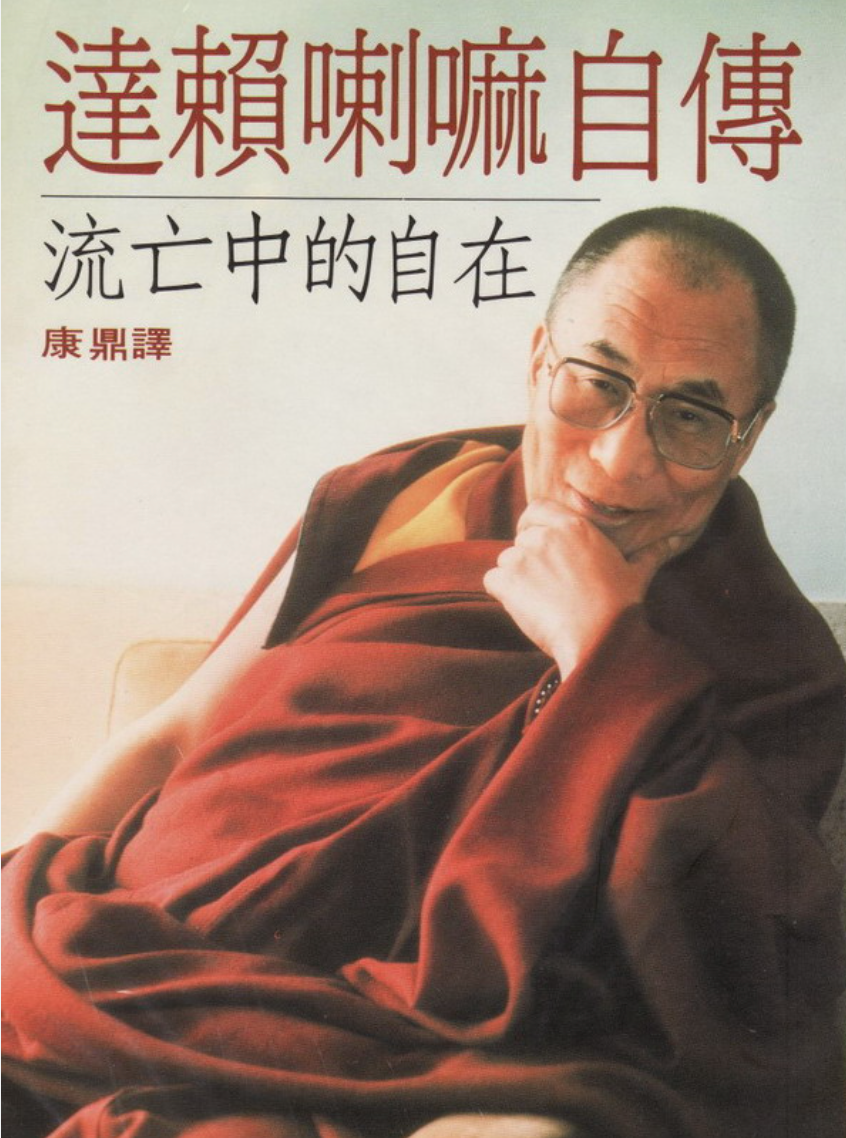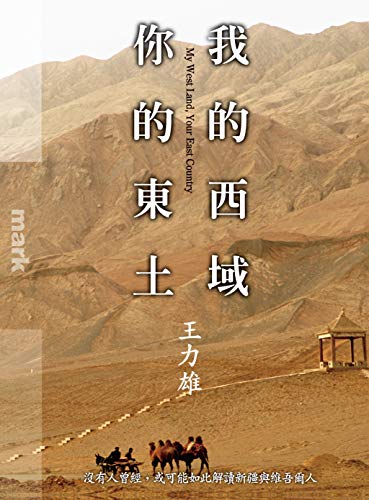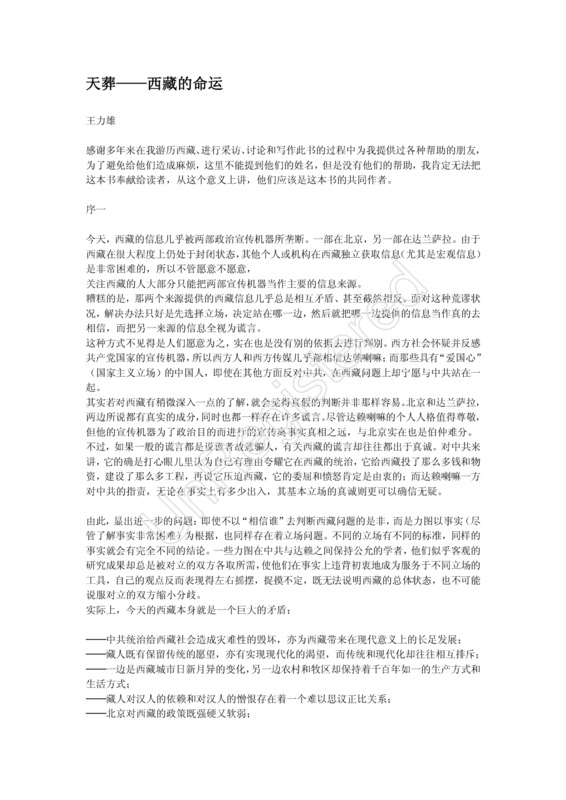Explore the collection
Showing 6 items in the collection
6 items
Book
My Western Region, Your Eastern Land
The first edition of this book was published two years before the landmark event on July 5 in Urumqi from which the ethnic problems in Xinjiang erupted. The "July 5 Incident" was an ethnic vendetta in Urumqi that resulted in thousands of deaths and injuries. It has been regarded as a turning point in the all-out hostility between Uyghurs and Han Chinese and in the shift of Xinjiang's governance from economic development to political high-handedness. The book is thus considered prescient and ahead of its time. Before writing the book, Wang Lixiong had been imprisoned for more than 40 days on the charge of "stealing secret state documents." But this imprisonment brought him a great reward: he was to meet Muhtar, an ethnic Uyghur who was also a political prisoner. "It was because of Muhtar that the book took on a new perspective," says Wang Lixiong. Xinjiang is no longer a symbol in documents, books and materials, but has real flesh and blood, emotions, and even body heat.
Book
Sky Burial: The Fate of Tibet
In this book, author Wang Lixiong presents his arguments with a great deal of personal experience and field work. The book covers the history of the Tibetan issue, the current situation, and various aspects. The book was first published by Mirror Books in Hong Kong in 1998, and an updated edition was released in 2009.
Book
Who is the New China
Author Xin Hao Nian tries to analyze the modern history of China since the Xinhai Revolution. He pointsout that the People's Republic of China (PRC) is a restoration of the authoritarian system, and the Republic of China (ROC) represents China's road to a republic. The first volume of the book defends and clarifies the history of the Kuomintang (KMT), arguing that the KMT is not a "reactionary faction" as claimed by the CCP. The second volume criticizes the revolution and history of the CCP. The book was first printed in 1999 by Blue Sky Publishing House (USA) and reprinted in June 2012 by Hong Kong's Schaefer International Publishing. It is banned on the mainland.
图书
Tangni Kütüp/Awaiting for the Dawn
(English follows) “Tangni Kütüp” namliq bu eslime épik dastan uslubida, yeni she’iriy shekilde yézilghan eser bolup, 1930-yillardin 1980-yillarghiche bolghan Sherqiy Türkistan (Xinjiang)ning siyasiy we ijtima’iy tarixini xelq éytimidin chüshinishte muhim ehmiyetke igidur.
Aptor Abduqadir Zununi Uyghurlarning 20-esirdiki siyasiy we ijtima’iy hayatida yüz bergen zor weqelerge shahit bolghan, shundaqla shu jeryandiki nurghun ishlarni öz béshidin ötküzgen shexstur. U 1940-yillardin bashlap Sherqiy Türkistanda neshir qilin’ghan Uyghur tilidiki asasliq gézitlerning tehriratida tehrir we bash muherrir bolup ishligen. Yene bir tereptin edebiy ijadiyet bilen shoghullinip, Uyghurlar hayatida yüz bergen zor ijtima’iy özgirishler we siyasiy heriketlerni yéqindin közetken.
Bu eslime bir tarixiy shahitning közidin Sherqiy Türkistanning yérim esirlik siyasiy we ijtima’iy hayatini hökümet meydanidin emes, belki shu tarixni yaratquchi awam xelqning éytimidin bayan qilip bergen. Mezkur eslime aptor tughulghan 1919-yilidin bashlap, tarixiy xironologiyelik tertip boyiche 1920-yillardiki Sherqiy Türkistanning jem’iyet ehwali, 1930-yillarning bashlirida yüz bergen Sherqiy Türkistan inqilabi we Uyghurlarning milliy musteqilliq heriketliri, Xitay militarist Shéng Shiseyning 1930-yillarning ikkinchi yérimidin bashlap élip barghan qanliq qirghinchiliqi, 1944-yili partlighan Ili inqilabi we uning netijiside qurulghan Sherqiy Türkistan Jumhuriyiti, Aptorning 1940-yillarning ikkinchi yérimida Chöchekte “Xelq Awazi” gézitide ishligen mezgildiki kechürmishliri tepsiliy bayan qilin’ghan. Eslimining kéyinki bölikide 1949-yilining axiri Xitay Xelq Azadliq Armiyesining Sherqiy Türkistan’gha bésip kirishi, Ilidiki Sherqiy Türkistan Jumhuriyitining emeldin qélishi we Milliy Armiyening Xitay Xelq Azadliq Armiyesining 5-korpusi qilip özgertilishi, Kommunist Xitay bilen Sowét ittipaqining 1950-yillarning bashliridiki Sherqiy Türkistanni sehne qilghan “shirin’ay munasiwiti” qatarliq témilar bir shahitning közidin bayan qilin’ghan.
Bu eslimidiki eng muhim mezmunlarning biri, aptorning Kommunist Xitay ishghalidin kéyin, yeni 1949-yilidin 1955-yilighiche bolghan ariliqtiki körgen we bilgenliridur. Aptor bir kespiy jurnalist, shair we közetküchi bolush salahiyiti bilen öz eslimiside Kommunist Xitay ishghalidin kéyinki Sherqiy Türkistanning künsayin nacharlashqan siyasiy weziyiti we mustebit tüzümning Uyghur xelqining siyasiy arzulirini qandaq qilip birmu-bir köpükke aylandurghanliqini inchikilik bilen teswirligen. Bolupmu sabiq Sherqiy Türkistan Jumhuriyiti (1944-1949) ning hayat serxilliri bilen Uyghur xelqining Kommunist Xitay hakimiyitige qoshulushtiki eng töwen sherti – Sowét Ittipaqi modélidiki Sherqiy Türkistan/Uyghuristan Ittipaqdash Jumhuriyiti qurush – telipining qandaq qilip ret qilin’ghanliqi, uning ornigha Xitayche uslubtiki atalmish milliy téritoriyelik aptonomiye – “Shinjang Uyghur Aptonom Rayoni”ning ustiliq bilen dessitilgenliki, shundaqla uning saxta mahiyiti inchike détallar bilen körsitilgen. Aptor bu eslimiside Xitay Kompartiyesining Xitay tarixidiki féwdalliq sulalilerning chégra xelqlirini “bölüp bashqurush” taktikisidin ustiliq bilen paydillanghanliqi, aldi bilen pütkül Xitay téritoriyesining altidin bir qismini teshkil qilidighan Sherqiy Türkistanni Qazaq, Mongghol, Qirghiz, Tunggan qatarliq rayondiki sani az milletlerning namida 5 aptonom oblast, 6 aptonom nahiye we nechche onlighan aptonom milliy yézilargha parchilighanliqi, eng axirida asasliq yerlik millet bolghan Uyghurlarning namida “eti ulugh suprisi quruq” ölke derijilik “Shinjang Uyghur Aptonom Rayoni”ni qurup chiqqanliqini tepsiliy bayan qilghan. Aptorning özimu “Shinjang Géziti” Uyghur Tehrir Bölümining bash muheririr bolush süpiti bilen 1950-yillarning bashliridiki bu weqelerge biwasite shahit bolghan bolup, eslimiside bu jeryanlarni öz eyni boyiche inchike bayan qilghan.
Eslimining axiriqi qismi aptorning 1955-yili wetendin ayrilip, a’ilisi boyiche Sowét Ittipaqigha köchüp ketkendin kéyinki musapirliq hayatigha béghishlan’ghan. Aptorning 1950-yillarning ikkinchi yérimida Tashkenttiki “Sherq Heqiqiti” Neshriyatining Uyghur bölümide tehrir bolup ishligenliki, 1960-yillarda Sowét Ittipaqining Tashkentte tesis qilghan Xitaygha qarshi Uyghurche radio anglitish bölümide xizmet qilghanliqi, 1979-yili pénsiyege chiqqandin kéyin, nurghun qétim iltimas sunup axirida, yeni 1986-yili ayrilghili 30 yildin ashqan wetini Sherqiy Türkistanni ziyaret qilghanliqi bilen axirlashqan.
Bu eslime 1991-1993-yilliri ariliqida Tashkentte yézilghan. Bu Sabiq Sowét Ittipaqi parchilinip, Ottura Asiyada 5 musteqil dölet dunyagha kelgen, Uyghurlarning Ottura Asiya Döletlirini merkez qilghan muhajirettiki milliy musteqilliq heriketliri kücheygen mezgiller idi. Bu waqitta 75 yashqa kirgen aptor qoligha qelem élip, özining bir ömürlük kechürmishlirini Sherqiy Türkistanning 20-esirdiki tarixiy jeryanigha birleshtürüp yézip chiqqan, shundaqla bu eslimide yene Uyghurlarning milliy musteqilliq iradisi bilen aptorning shexsiy arzulirinimu melum derijide eks-ettürgen.
Aptor hayat waqtida bu eslimisini resmiy neshir qilish imkaniyitige érishelmigen. Aptor wapat bolghandin kéyin, bu eslimining qolyazmisi muhajirettiki Uyghurlar arisigha tarqilip, bir qisim Uyghurche tor betlerde tonushturulghan.
<i>Awaiting for the Dawn</i> is an epic narrative memoir written in verse form that chronicles the political and social transformations of East Turkestan (Xinjiang) from the 1930s to 1980s, providing a precious text for understanding this history from a witness’s perspective. The author, Abdukadir Zununi, was both a witness to major changes in 20th-century Uyghur society and a senior editor and literary creator for major Uyghur-language newspapers in East Turkestan from the 1940s onward. This dual identity gives the work unique historical depth.
This work breaks through the framework of official historiography, using grassroots narrative to reconstruct half a century of East Turkestan's historical landscape: from the Uyghur socio-political situation in the 1920s, the East Turkestan revolution and national independence movement of the 1930s, and the bloody rule of warlord Sheng Shicai, to the Ili Revolution that erupted in 1944 and the establishment of the East Turkestan Republic. The author provides detailed accounts of his experiences at the Uyghur-language Voice of the People, the newspaper which published in Chöchek (Tarbaghatay/Tacheng) during the East Turkestan Republic’s period in 1945-1949, as well as major events including the occupation of East Turkestan by the Chinese People's Liberation Army in late 1949, the dissolution of the East Turkestan Republic headquartered in Ili, the reorganization of the National Army into the Fifth Corps of the Chinese People's Liberation Army, and the geopolitical maneuvering during the Sino-Soviet “honeymoon period” in Xinjiang in the 1950s.
The memoir's core chapters focus on the dramatic social changes in East Turkestan under Chinese Communist rule from 1949-1955. With the keen eye of a professional journalist, the author records how the CCP's totalitarian system crushed Uyghur national political aspirations—the Soviet model concept of an “East Turkestan/Uyghurstan Union Republic” was brutally rejected and replaced with the “Xinjiang Uyghur Autonomous Region,” which promised autonomy but did not grant it. In this memoir, the author details how CCP authorities continued the “divide and rule” governance strategy of China's historical feudal dynasties, first dividing the East Turkestan territory (which comprises one-sixth of China's land area) into 5 autonomous prefectures, 6 autonomous counties, and dozens of ethnic townships named after minority populations including Kazakhs, Mongols, Kyrgyz, and Hui, ultimately establishing under the name of “Xinjiang Uyghur Autonomous Region”, which “bears the Uyghur name but operates as a hollow shell.” The author's perspective as editor-in-chief of the Uyghur edition of Xinjiang Daily lends credibility to his insider narrative.
In the latter part of the memoir, the author recounts his career after fleeing to the Soviet Union in 1955: serving as Uyghur editor at Oriental Truth Publishing House in Tashkent in the late 1950s; participating in Soviet government-established Uyghur-language broadcasts to China from Tashkent in the 1960s; and the complex emotions surrounding his return to East Turkestan in 1986 after multiple applications following his 1979 retirement—a homeland he had been separated from for over 30 years.
The memoir was completed between 1991-1993 in Tashkent, coinciding with the dissolution of the former Soviet Union, the independence of the five Central Asian states, and a surge in overseas Uyghur independence movements. The 75-year-old author wove his life experiences into the intersection of personal destiny and 20th-century East Turkestan history, while expressing both national independence ideals and personal sentiments.
The hand-written memoir manuscript was not formally published during the author's lifetime. After his death, it scattered like sparks throughout overseas Uyghur communities, being secretly copied in Istanbul coffeehouses and underground reading circles in Almaty and Tashkent. Some Uyghur-language websites have published excerpts. CUA offers a PDF of the original handwritten manuscript.
图书
Köz Yéshida Nemlen'gen Zémin/The Land Drenched in Tears
(English follows) Bu kitab muhajirettiki Uyghur jem’iyitide nisbeten baldur neshir qilin’ghan, shundaqla Uyghur ziyaliylirining kommunist Xitay hökümranliqi astidiki paji'elik kechürmishlirini inchike détallar bilen teswirlep bergen edebiy xatire sheklidiki eslimidur. Téximu éniqraq qilip éytqanda, bu kitabta aptorning charek esirlik ré'al kechürmishliri asasiy liniye qilinip, 1957-yilidin 1982-yilighiche bolghan 25 yil jeryanida Sherqiy Türkistan (Shinjang)diki Uyghur istudéntlarning boran-chapqunluq sergüzeshtiliri we tragédiyelik teqdiri yorutup bérilgen.
1957-Yili Séntebirde emdila 17 yashqa kirgen Söyün'gül Chanishéf (aptor) Shinjang Méditsina Inistitutigha qobul qilinidu. Bu pütün Xitay miqyasida Maw Zédung bashlatqan «échilip-sayrash» dolquni emdila axirliship, «istil tüzitish» herikiti bashlanghan, Shinjang Uyghur Aptonom Rayonida «yerlik milletchilikke qarshi heriket» élip bérishning teyyarliqi jiddiy élip bériliwatqan mezgiller idi.
Söyün'gülning siyasiy dolqunlar ichide bashlanghan aliy mektep hayati uning kéyinki teqdiride oylap baqmighan qarangghu sehipilerni achidu. U Méditsina Inistitutidiki bashqa Uyghur sawaqdashliri bilen birlikte siyasiy jehette «échilip-sayrash»qa, «istil tüzitish» yighinlirigha qatniship, kompartiye heqqidiki pikir-qarashlirini ochuq otturigha qoyushqa mejbur qilinidu. Yashliq bahari urghup turghan, kelgüsige ümid bilen qarighan, emma siyasiy boran-chapqunlarda téxi pishmighan bu bir türküm sap-sebiy we qizghin oqughuchilar köz aldidiki rehmisiz siyasiy ré'alliqtin qattiq ümidsizlinidu. Sabiq Sowét Ittipaqi modélidiki ittipaqdash jumhuriyetlik aliy aptonomiye tüzümini Xitaydiki Uyghur, Tibet, Mongghul qatarliq az sanliq milletlerning aliy aptonomiye hoquqining tüp kapaliti dep bilgen bu yashlar, Xitay kompartiyesining Xitayche uslubtiki «milliy téritoriyelik aptonomiye tüzümi»din qattiq narazi bolidu. Ular, Shinjangda ölke derijilik atalmish «Shinjang Uyghur Aptonom Rayoni» emes, belki Sowét Ittipaqi modélidiki «Sherqiy Türkistan/Uyghuristan Ittipaqdash Jumhuriyiti» qurulushi kérek, dep qaraydu. Ularning «échilip-sayrash» yighinlirida dadilliq bilen otturigha qoyghan bu pikir-telepliri, kéyinche ularning siyasiy jehettiki qéchip qutulalmas éghir jinayiti bolup qalidu.
Shuningdin kéyinki polat tawlash, chong sekrep ilgirilesh, yerlik milletchilikke qarshi heriket jeryanida Söyün'gülni öz ichige alghan yerlik millet oqughuchiliri qattiq tenqid we teqipke, siyasiy bésim we rohiy azablargha duch kélidu. Acharchiliq yillirining éghir riyazetlirini béshidin ötküzidu. Xitay kompartiyesining az sanliq milletlerge qaratqan aldamchiliq siyasiti we saxta aptonomiyesining mahiyitini chongqur chüshinip yétidu. Netijide ularda mexpiy teshkilat qurup, yer asti siyasiy küresh pa'aliyetliri bilen shoghullinish; kéyinche shara'it piship yétilgende yerlik xelqni qozghap keng kölemlik milliy azadliq sépi shekillendürüsh; Xitay mustemlikisidin qutulup, Sherqiy Türkistanning musteqilliqini qolgha keltürüshtek siyasiy ghaye hem pikir birliki hasil bolidu. Ular 1962-yili 2-ayning 5-küni Shinjang Méditsina Inistitutining oqughuchilar yataq binasida mexpiy yighilip, «Sherqiy Türkistan Méhnetkesh Xelq Partiyesi» namliq siyasiy teshkilat quridu. Söyün'gül Chanishéf bu teshkilatning katipliq wezipisini öz üstige alidu. Halbuki, aridin birqanche ay ötmeyla Xitay Jama'et Xewpsizlik organlirining oqughuchilar arisigha mexpiy orunlashturghan jasuslirining uchur yetküzüshi bilen bu teshkilat pash bolup qalidu. Shu yili 4-ayning 29-küni Söyün'gül Chanishéfni öz ichige alghan nechche onlighan Uyghur oqughuchilar qolgha élinidu.
Shuningdin bashlap Söyün'gül we uning sawaqdashlirining uzun yilliq türme we mejburiy emgek hayati bashlinidu. Ürümchi türmisidiki 4 yilgha sozulghan qiyin-qistaq we qarangghu türme hayatidin kéyin, Söyün'gül we uning türmidishi Sajide Ürümchi etrapidiki emgek bilen özgertish lagérida mejburiy emgekke sélinidu. Bu jeryanda insan tesewwur qilghusiz teqip we qiyin-qistaqlargha, künige on nechche sa'etlik éghir emgekke, achliq we rohiy azablargha duch kélidu. Medeniyet Inqilabi bashlinishi bilen ularni téximu éghir qismetler kütiwalidu. Söyün'gül «siyasiy jinayetchi» dégen qalpaq bilen Ürümchi etrapidiki bir xelq kommunasigha yerleshtürülüp, ammining nazariti astida éghir emgek arqiliq özgertishke tapshurup bérilidu. U bu yerde türmidinmu better qiyin künlerge duch kélidu. Rohiy we jismaniy jehettin qattiq xorlinidu. Uzun yilliq türme, mejburiy emgek we qiyin-qistaq Söyün'gül Chanishéf we uning tutqundiki sawaqdashlirini öz ichige alghan bir ewlad Uyghur yashlirining yashliq baharini, arzu-armanlirini, ghaye we intilishlirini xazan qilidu. 1976-Yiligha kelgende Xitay kompartiyesining aliy rehbiri Maw ölüp, «Medeniyet Zor Inqilabi» axirlashqan, 1978-yili kommunist Xitayning milletler siyasitide «yumshash» bashlanghan bolsimu, emma Söyün'gül Chanishéf qatarliq «siyasiy jinayetchi» qalpiqi kiydürülgen bir ewlad Uyghur oqughuchilarning délosi hel bolmaydu. 1980-yillarning bashlirigha kelgende, Xitayning siyasiy atmosférasida körülgen «islahat» we «ishikni échiwétish» dolqunidimu héchqandaq siyasiy kengchilikke érishelmigen Söyün'gül pütün a'ilisi bilen birlikte tughulup ösken yurtini tashlap Awstraliyege köchmen bolup kétidu. Shundaq qilip, Söyün'gülning Sherqiy Türkistandiki 18 yilliq türme we tutqunluq hayati axirliship, erkin dunyadiki kéyinki hayati bashlinidu.
Bu eslime aptor Söyün'gül chanishéfning muhajirettiki hayati dawamida eyni waqittiki kündilik xatirisi bilen türme xatirilirini retlesh, toluqlash, qayta eslep yézish arqiliq wujutqa chiqqan. Pütün kitab 700 betke yéqin uzun sehpidin teshkil tapqan bolup, tili addiy, uslubi yenggil we güzel, hékaye weqeliki jiddiy we jelp qilarliq shekilde yézilghan. Bu kitab peqet aptorning béshidin köchürgen shexsiy kechürmishlirining addiy bayani bolupla qalmastin, belki 1950-yillarning axiridin 1980-yillarning bashlirighiche bolghan bir ewlad Uyghur istudéntlirining boran-chapqunluq kolléktip hayati we Uyghur ziyaliylirining kommunist Xitay réjimi astidiki paji'elik teqdirining janliq örnikidur.
Aptor kitabning bash qismigha yazghan kirish sözide, «musteqilliq arzusi bilen teshkilat qurup qolgha élin’ghan hemde türme we nazaret astida yashighan 18 yilliq hayatimdin qisqiche xatire qaldurup, yoshurun saqlap kelgen idim. Shu xatirige asasen bu kitabni yézip chiqtim. Bu kitabtiki weqelerning hemmisi béshimdin ötken, öz közüm bilen körgen hem anglighan heqiqiy ishlardur» dep yazghan. Istanbul Uniwérsitétining Uyghur proféssori Sultan Maxmut Qeshqeri bu kitabqa yazghan béghishlimisida «<köz yéshida nemlen'gen zémin> namliq bu kitabta yézilghan weqeler toqulma hékayiler we xiyaliy épizotlar bolmastin, hemmisi Söyün'gülning béshidin ötken we öz közi bilen körgen rast weqelerdur. Bu kitabta kommunist Xitay hakimiyitining Sherqiy Türkistanda yürgüzgen insan qélipidin chiqqan wehshiy siyasetliri emeliy pakitlar bilen chongqur pash qilinghan, bolupmu Maw Zédung bashlatqan <Medeniyet Inqilabi>ning dehshetlik menzirisi de dölet térori nahayiti janliq ipadilep bérilgen» dep yazghan.
Bu kitab 2006-yili Istanbuldiki Teklimakan Uyghur Neshriyati teripidin birinchi qétim neshir qilin’ghan. Kitab muhajirettiki Uyghur oqurmenliri arisida zor tesir peyda qilghan we bazarliq kitabqa aylanghan. 2015-yili yuqiri tiraj bilen ikkinchi qétim bésilghan. 2018-Yili in'gilizchigha terjime qilinip, En'giliyede neshir qilinghan.
<i>The Land Drenched in Tears</i> is the one of the earliest literary memoirs published in the Uyghur language within the diaspora community, detailing the experiences of Uyghur intellectuals under Chinese Communist rule. The book, written by Söyüngül Chanisheff, chronicles the turbulent experiences and tragic fate of Uyghur students in East Turkistan (Xinjiang) during the 25 years from 1957 to 1982, centered around the author’s quarter-century of real-life experiences.
In September 1957, Söyüngül, who had just turned 17, was admitted to Xinjiang Medical Institute. This was a time when Mao Zedong’s Hundred Flowers Campaign had just ended nationwide, the Rectification Movement had begun, and the Xinjiang Uyghur Autonomous Region was intensively preparing for the Anti-Local Nationalism Campaign. Along with other Uyghur classmates at the Medical Institute, Söyüngül was forced to participate in political “speaking out” meetings–when people were encouraged to voice criticism about the Communist Party. However, their bold views and demands expressed during these “speaking out” meetings later severe criticism, persecution, political pressure, and psychological torment during the Anti-rightist Campaign.
On February 5, 1962, they secretly gathered in a student dormitory at Xinjiang Medical College and established the East Turkistan Working People’s Party, with the political ideal and common goal of freeing themselves from Chinese rule and achieving independence for East Turkestan. Söyüngül Chanisheff served as the organization’s secretary. Just months later, due to an informant placed among students by Chinese security forces, the organization was exposed. On April 29 the same year, dozens of Uyghur students, including Söyüngül, were arrested.
In the subsequent years, Söyüngül went through imprisonment, as well as forced labor at labor camp and a people's commune, where she suffered severe physical and psychological damage.
Although Mao died in 1976, ending the Cultural Revolution, and China’s ethnic policies began to soften in 1978, cases like Soyungül’s were never rehabilitated. By the early 1980s, even amidst China’s reform and opening political atmosphere, Söyüngül —still denied any political clemency—eventually left her homeland with her family and emigrated to Australia.
This memoir was created during the author’s life in exile, based on her contemporary diaries, reorganized prison notes, and reconstructed memories. The nearly 700-page book is not merely a simple account of the author’s personal experiences, but also serves as a vivid portrayal of the turbulent collective life of a generation of Uyghur university students from the late 1950s to early 1980s, and the tragic fate of Uyghur intellectuals under the Chinese Communist regime.
The book was first published in 2006 by Taklamakan Uyghur Publishing House in Istanbul. It had a significant impact among diaspora Uyghur readers and became a bestseller. A second edition with higher circulation was published in 2015, and an abbreviated English translation was published in the UK in 2018. <a href="https://www.foyles.co.uk/book/the-land-drenched-in-tears/s-y-ng-l-chanisheff/9781910886380">The English edition can be purchased here</a>.





